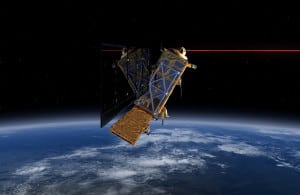Latest News

The Laser Communication Terminal (LCT) unit on Sentinel-1 transmits data to the ground facility via the European Data Relay Satellite (EDRS). Photo: ESA
[Via Satellite 06-18-2015] The European Space Agency (ESA) and partner Airbus Defence and Space are aiming to build out the European Data Relay System (EDRS) into a global laser communications network by 2020 and hope that the system will become an international standard.
ESA and Airbus completed a major test of the EDRS system in late 2014, linking the Sentinel 1A satellite built by Thales Alenia Space with the Airbus-built Alphasat satellite via Laser Communication Terminals (LCTs). The test beamed images from Sentinel 1A, which circles the planet at 700 kilometers in Low Earth Orbit (LEO) to Alphasat 36,000 kilometers up in Geostationary Earth Orbit (GEO) and back to the ground. ESA reaffirmed its commitment to EDRS in January of this year.
Magali Vaissiere, director of telecommunications and integrated applications at ESA, stated on June 17 at the Paris Air Show that the Copernicus program and the European Columbus Laboratory module of the International Space Station (ISS) are preparing to use EDRS communications starting in 2015 — subject to the availability of Proton — and 2018 respectively. Eutelsat 9B, which carries the EDRS-A payload, is pending launch based on the return of the Proton rocket. Airbus Executive Vice President of Communications, Intelligence and Security, Evert Dudok, said Eutelsat 9B is second in Proton’s launch queue following Inmarsat 5-F3. The next laser communications payload, EDRS-C, is scheduled to launch on Avanti’s Hylas 3 satellite in 2017 with Arianespace. OHB AG of Bremen, Germany is building the Avanti satellite, while Airbus built the Eutelsat satellite. Vaissiere said EDRS has service capacity set aside for ESA and ESA-partner missions and that there is ample opportunity for others to leverage the relay system.
“This indeed provides opportunities for cooperation with international partners requiring data relay capabilities for their own programs. It is also for this that we have opened up the laser communication terminal specification to international standardization,” she said.
Dudok echoed the desire to expand the use of EDRS. The company is spearheading efforts to increase the system’s commercial use.
“For us, the key goal as private partners is to commercialize this data and make best use of that for commercial partners and get the Space Data Highway as soon as possible deployed and used by third parties,” he said.
ESA and Airbus signed a service-level agreement in February to provide EDRS services to the Copernicus Sentinel 1 and 2 dedicated missions, beginning this year and reaching to 2021, with an option for extension until 2028. Arianespace is currently preparing the Sentinel 2A satellite for launch aboard a Vega rocket, where it will join Sentinel 1A, which launched in April 2014. Simon Jutz, head of ESA’s Copernicus Space Office said having just one satellite in orbit has produced a tremendous amount of data and that EDRS may prove instrumental to getting full use of the larger constellation.
“[Sentinel 1A] produces around 1.8 terabytes of raw data every single day, and when we process this data it is even three terabytes, more or less, on average we produce everyday. In 2017 we will have seven Sentinels working and roughly seven times the amount of data to download. Four of these Sentinels will have a laser communication terminal and can use EDRS,” he said.
Sentinel satellites 1A, 1B, 2A and 2B all have LCT payloads.
Stefan Klein, head of aviation division General Atomics, Spezialtechnik, said his company is eager to use EDRS laser communications for its Unmanned Aerial Vehicles (UAVs). Today the company’s drones get up to 40 hours of flight without refueling, and require real-time data through secure communications. The company plans to build LCT payloads to leverage EDRS by the end of the decade.
“Most of the missions that we perform, both civilian and military, are time-critical missions where real-time information is absolutely necessary. We face the constraints of the current system with the electromagnetic spectrum where we see the bandwidth and frequency is limited as well as the antenna size and power requirements that are not always compatible with the space available on UAVs. These two requirements and the constraints of the current system leads to the fact that lasercomm for us is the way to close this gap,” said Klein.
Spezialtechnik has its Preliminary Design Review (PDR) later this year. The company hopes to complete a ground demonstration with Alphasat in the next two years. An airborne demonstration would follow in 2018 or 2019, Klein said.
Copernicus does face challenges due to the lack of uniformity with its ground segment. Reinhard Schulte-Braucks, head of Copernicus infrastructures, European Commission, said that what is supposed to be a collaborative ground segment is “fragmented at the moment.” He attributed this to the desire of certain member states to have direct data downloads using X-band stations located around the world. EDRS could alleviate this, he said.
“EDRS can help. It reduces the need and probably obviates the need for direct data downlinks via X-band stations and therefore leads to a more homogenous operation of the ground segment,” said Schulte-Braucks.
The European Commission has started working on the next generation of Sentinel satellites, which are to orbit starting in 2030. By the time this system is in orbit, Schulte-Braucks expects EDRS could be all but essential.
“We are in the process of establishing the user requirements and we know that the next generation of the Sentinels will come to the limits of what you can download with X-band stations. We will most probably need EDRS to a much greater degree in this next generation in order to deal with the much higher data volumes that we will have at that time,” he said.
Get the latest Via Satellite news!
Subscribe Now